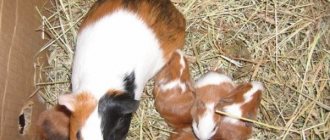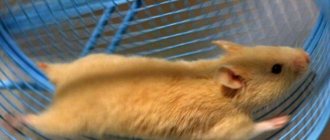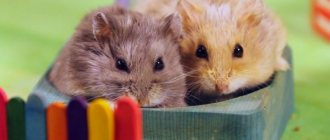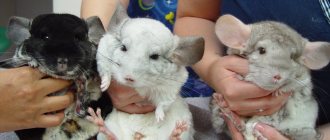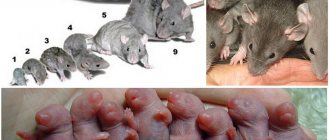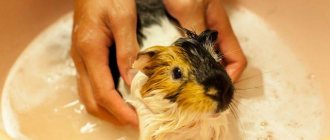- home
- Reproduction
01/25/2019 Newborn hamsters will not bring trouble to the owner if you provide comfortable living conditions for their mother. Therefore, the main emphasis is on proper feeding and creating a favorable indoor microclimate for the female.
What do newborn hamsters look like?
Newborn hamsters are completely hairless, so they look like a red, swarming mass. Their ears and eyes are closed; only their sense of smell allows them to navigate. Babies may squeak loudly if they are cold or hungry. If the mother takes good care of the offspring, the babies do not make a sound. Sometimes the owner discovers that there are newborn hamsters in the house, by accident - when cleaning the cage, or when grown-up children of hamsters begin to crawl out of the nest.
Newborn hamsters
A baby hamster is no larger than the phalanx of a finger, weighing 1-2.5 g. In the first days, it can be difficult to count the offspring, especially since the female feeds the children, lying on them with her whole body. It is not recommended to look into the house so as not to disturb the hamster.
Although dwarf hamsters are much smaller in size, newborn Syrian hamsters are not very different in size from dwarf hamsters. The fact is that Syrians are multiple: the more children in one litter, the smaller the size of each hamster.
Newborn Hamster Size
What to tell your child
The death of a pet is always a big blow for the whole family, and children are especially sensitive to this. Parents may feel confused about what to do if their hamster dies.
In what words to convey the news of the death of a pet to a child depends on the age of the child and on whether the parents explained to him what death is. However, you should not hide the fact of the animal’s death from the child, because in any case he will have to face death in the future. It must be remembered that at such a difficult moment the child needs special attention from the parents. You should not leave your child alone with his grief - you need to talk to him a lot and provide moral support. You should not scold if your child’s grades at school temporarily deteriorate. It takes time to get over grief. There is no need to immediately get another animal to replace the old one. All the same, the new pet will be completely different in character and habits, which is why it is important to completely mentally say goodbye to the deceased hamster.
How many children does a hamster give birth to?
The reproductive abilities of these rodents have long been the subject of jokes. Their fertility is really high, especially at home, when hamsters do not hibernate and receive an abundance of food. The ability to reproduce rapidly is a quality that makes rodents so popular as laboratory animals.
Hamsters can give birth to a different number of babies depending on the species and conditions of detention. It is quite precisely known how many hamsters are born to Djungarians - from 4 to 6 pieces. Rarely – 8-9 cubs. Due to their size, dwarf hamsters are not as fertile. But having learned how many hamsters a Syrian hamster can give birth to, an amateur breeder sometimes grabs his head. The average number is 6-10 babies, but sometimes there are 16-18, occasionally even 20 pieces.
The number of babies a hamster can give birth to - both the Djungarian and the Syrian - does not correspond to the number that the female is able to feed. Some of the numerous offspring die or are devoured by the mother. Therefore, the number of surviving hamster babies does not exceed 10-12.
Causes of hamster death
Let's look at the most common causes of death in a hamster.
- Age. Due to natural reasons, rare individuals live more than three years. Even if an animal is kept in ideal conditions and receives normal food, its organs are capable of functioning for no more than a period determined by nature.
- Poor nutrition. Hamsters eat any food, but not all food is good for them. Spicy, sour and salty foods should not be given. Smoked meats and foods with spices are contraindicated. It is unacceptable to feed your pet stale or rotten foods, exotic fruits and sweets. All kinds of chips, crackers and other products containing food additives and stabilizers can be deadly for a small animal.
- Colds. Hamsters are sensitive to hypothermia and drafts. The optimal air temperature for keeping an animal is 20–22 °C, away from direct sunlight and heating devices. You should not bathe your rodent often. He may catch a cold after taking water treatments if his fur coat is not thoroughly wiped and dried. At the first signs of illness (lethargy, apathy, refusal to eat), do not self-medicate, take the animal to a veterinarian. The life of a hamster is fleeting, and diseases occur at lightning speed. Don't miss the time when you can still save your baby.
How to care for newborn hamsters
A newborn Djungarian hamster is a helpless creature that is completely dependent on the actions of its mother. Cubs need warmth and food. The temperature in the room is maintained at least 21 C, but not higher than 25 C. If the female takes care of the offspring on her own, the owner will not need to care for the born hamsters.
It is extremely rare to raise babies under 10 days of age without a mother.
At home, caring for cubs comes down to caring for their mother. In the case of rodents, the best help is to stay out of the way. The female and children need privacy. Baby Djungarian hamsters will be in mortal danger if their mother is stressed.
Host actions:
Feeding
Usually the owner feeds the hamster, and the hamster feeds its babies. The female must be provided with plenty of water and food, including a source of protein and succulent food. If the mother has enough milk, there is no need to feed the cubs. You can throw grated carrots, low-fat cottage cheese and other foods into the baby’s nest if the hamster does not do this. Food is placed in the cage with the expectation that any product can be tasted by Djungarian babies.
Arrangement of the cage:
- Litter.
It's good if there is a house in the cage. If it is not there, you need to put a small cardboard box. If the female is provided with materials for construction, she will cope with the arrangement of the home herself. In addition to sawdust or other filler, paper towels are placed in the cage. It is forbidden to use cotton wool or rags; these materials are dangerous for baby hamsters (they can get entangled and suffocate). General cleaning is not carried out for at least 2 weeks.
- Safety.
Sometimes, even with a caring mother, the question arises - what to do with newborn hamsters that have fallen out of the nest. To prevent the baby from freezing or catching a cold, it is better to return him to his brothers and sisters. But not with your hand, but with a spoon on a long handle.
At 10-12 days, a newborn hamster begins to explore the world around him; he cannot be kept in the nest. There should be no differences in height (tiers) in the cage; pay attention to the distance between the bars (whether the baby will fall out). Do not place water in an open bowl. Feeders are placed so that they are accessible to babies.
Injuries at 3-4 weeks of age are possible in the running wheel. It is interesting to watch young Djungarian hamsters during games, but in this case the wheel should not stand on a stand (hang on the wall) and be solid, without crossbars.
- Privacy.
The cage should be in a quiet place so that no loud noises can be heard. It is protected from the sun's rays. Drafts are not allowed. Children are explained that caring for small hamsters takes up all their free time, and they cannot pick them up for play for 2-3 weeks.
When the animals grow up and are placed in other cages, caring for dwarf animals includes daily hand training. Otherwise, they may bite the hands of the new owner. Syrians are more friendly, but detailed instructions on how to care for a small hamster will be useful.
Important nuances of hamster pregnancy
Sometimes owners find out that the pet was pregnant only during childbirth. But some animal lovers specifically purchase a pair of rodents of different sexes for breeding purposes.
Unexpected birth
If a hamster gives birth, all other rodents must be removed from the cage immediately.
Over the next 2 weeks, interference in the life of the cubs, penetration into the cage should be minimal.
Refuse cleaning and do not touch newborns. The appearance of foreign odors will frighten the female and may lead her to decide to eat the hamsters.
Planned replenishment
Take care of proper nutrition for the pregnant woman. Her diet includes more protein foods, fruits, vegetables, and also increases the amount of food and liquid due to increased energy costs. It is necessary to regularly change the water in the drinking bowl. It is better to use spring or bottled water, since tap liquid contains a lot of bleach that is harmful to rodents.
The partner and other relatives should be moved to another cage. Neighbors can disturb a pregnant woman and create stress, so before giving birth and during the first weeks after the birth of the cubs, it is better for the female to remain alone.
How do hamsters grow?
The reproduction of Djungarian hamsters, like the reproduction of Syrian hamsters, occurs extremely intensively. Hamsters and their babies are the embodiment of rapid development. First, the fetuses gain weight in the womb in a matter of days, and then continue to grow just as quickly after birth.
A day after birth, red, naked babies turn pink or darken, depending on the color of the fur that has broken through. By day 4, you can distinguish the color of dark hamsters; light ones look pink, but not hairless.
Newborn hamsters are 4 days old
A newborn hamster is a rather helpless creature. All they can do is squeak and move their paws. They find the mother's nipple by smell. On days 5-6, the cubs' ears protrude and they begin to hear.
Hamsters grow very quickly. At the age of 1 week, babies are already covered with fluff and begin to try solid food. Like true rodents, they were equipped with sharp teeth from the first day of life. The first food after mother's milk is often your own feces. Coprophagia is a natural process necessary to populate the intestines with the correct microflora. The babies also try the food brought by the female to the house.
Newborn hamsters aged 1 week
On days 9-12 after birth there is a real developmental leap. The hamsters begin to crawl out of the nest, although their eyes are still closed. They eat solid food - greens and vegetables, grain mixture. They learn to use the toilet corner, being naturally clean. On the first day of such walks, the hamster may worry and try to gather the babies back into the nest. Pretty soon she gets tired of it, and the kids, staggering and falling, scatter around the cage. By the time they leave the nest, they are completely covered with hair.
Newborn hamsters are 9-12 days old
When do hamsters open their eyes?
Immediately after birth, the cubs are blind, their eyes are tightly closed. Regardless of what day hamsters open their eyes, this is a new stage in the lives of babies. From this moment on, they begin to get used to being handled, and the hamsters themselves actively explore their surroundings.
The eyelids begin to open slightly from the 13th day of life, narrow slits are visible. On the 14th day or a little later, by the 16th day, the eyes open completely. Djungarians open their eyes a little earlier than Syrians, sometimes on the 12th day, which is explained by the longer pregnancy of dwarf animals.
Newborn hamsters 13-16 days
Development after 2 weeks
Starting from the 15th day, the mother is no longer able to tolerate grown offspring. The owner has to make sure that the hamsters sleep together in a warm place, returning stray animals to the house. At 15-16 days, babies are quite dexterous - they wash themselves and overcome obstacles. At 17-20 days, baby hamsters, Djungarians and Syrians, begin to use a running wheel, if given the opportunity. After 20 days, the animals can already feed on their own.
It is difficult to say at what point a young hamster becomes an adult. The age of puberty does not correspond to how long hamsters grow. Pregnancy is possible as early as one month of age, active growth continues until 2.5-3 months. A hamster can gain weight and mate for up to 4-5 months. After this, the increase in the size of the animal can only be associated with obesity, and not growth.
At what age will the cubs open their eyes?
As mentioned earlier, at birth, baby hamsters are blind and navigate in space due to their excellent sense of smell. The opening of the eyes is considered a new, important stage in the development of cubs. From this moment on, they can be safely picked up and taught to explore their surroundings. The eyes begin to open about a couple of weeks after birth. And by day 16, the eyes of healthy individuals usually open completely. It is worth noting that Djungarian hamsters open their eyes earlier than their Syrian counterparts: this is explained by the mother’s longer pregnancy.
When can you handle newborn hamsters?
During the first two weeks after the birth of the offspring, it is not recommended to stick your hand into the cage, even to leave food. Cleaning the cage is prohibited. Touching newborn hamsters means putting their lives at risk .
The female can eat the cubs by smelling someone else's scent.
No matter how much curiosity there is, there is no need to pick up or stroke babies. Sometimes droppings are weighed for scientific purposes, or a dropped baby needs to be returned to the nest. Then the animal is taken not with the hand, but with a spoon or other suitable object. If you still need to pick it up, you need to use latex gloves and dump the baby in the toilet corner before returning it to the mother.
Babies begin to get used to being handled at the age when they can already survive without the care of a female, that is, no earlier than 2 weeks. In order not to count down the days until the moment when you can meet the hamsters, you need to focus on opening your eyes (do not touch blind children).
The age of 14-21 days is the optimal time for the first acquaintance.
Preparing for a new addition to the family
After you have established the fact of pregnancy, you need to prepare for replenishment. The most important thing an expectant mother needs is peace. A couple of days before the expected event, you can no longer approach the cage without reason, move the bedding and try to play with the hamster. Therefore, preparation must be done in advance.
This is what the expectant mother needs:
- Lack of a partner. A week before giving birth, the male should be transplanted into another cage. It should not distract the hamster from preparing for childbirth and nursing the offspring.
- Revision of nutrition. The percentage of protein in the female's diet should be increased. Buy her a special protein food, little by little give her boiled egg whites and low-fat cottage cheese in small quantities to replenish calcium losses.
- Purity. It is necessary to clean the cage in advance. 2-3 days before the addition to the family, the hamster will not allow you to do this. Therefore, clean up after you remove your partner from the cage. It is worth keeping in mind that after giving birth, the bedding cannot be changed for 2 weeks (so as not to harm the babies and not irritate the young mother). Based on this, sawdust should be poured 2-3 times more than usual.
- Space. Remove the wheel and other attractions from the cage, because the hamster will have no time for sports in the near future; the toys will only get in the way. But leave the house, where a caring mother can hide supplies.
- A lot of food. In the first week after birth, you should not climb into the cage. Therefore, replace the food bowl with a larger one and fill it to the top with dry food for rodents.
- Nest material. Of course, you can make a nest from sawdust, but it will seem hard and prickly to the kids. Throw paper napkins or toilet paper to the hamster, she will use it for construction.
Attention! Do not put large quantities of fruits and vegetables in the cage! They spoil very quickly. It’s better to stick a small piece through the bars once a day.
While the female is preparing for childbirth and feeding the hamsters, your task is to find a new family for the babies.
When can you give away hamsters after birth?
Hamsters cannot be given away immediately after weaning. They are divided into two groups by gender and placed in separate cages. This should be a full-fledged home with a drinking bowl, a house, a wheel and other toys. The cage for dwarf hamsters should be no smaller in size than for Syrian hamsters.
When the female relinquishes her responsibility for caring for the children, the owner’s troubles increase. It is not surprising that people are interested in at what age young animals can be given away. Moving to a new home is a lot of stress for Djungarian babies. It is optimal to distribute them at the age of 1.5-2 months, i.e. 6-8 weeks.
As a rule, breeders try to give away animals early. After all, at 7-8 weeks fights for territory may begin, and each young hamster will need to be provided with an individual cage. In a good nursery, the grown rodents are resistant to disease and are accustomed to handling. Along with the hamster, you should give some used litter and food for several days. A familiar smell and familiar diet reduce the stress of moving.
Death from old age
If the pet has been living for about three years, be prepared for the inevitable death of the pet from old age. A small heart, which in a calm state beats at a frequency of 180-200 beats per minute, wears out very quickly. With frequent stress, the likelihood of rupture of the heart muscle, i.e., a heart attack, increases many times over. Tiny vessels cannot withstand such a frantic rhythm. Hence strokes and paralysis of limbs. The baby is still alive, but cannot move. It’s up to you whether to prolong his torment or contact a veterinary clinic with a request to euthanize the dying man.
What to feed a baby hamster
Newborns
If the cubs are left without a mother, or the female does not have milk, the owner can feed them. The task is not easy: small hamsters need to be fed every 1.5 hours. Use soy-based infant formula 0+, dissolving and heating according to instructions. Sometimes they take Royal Canin cat milk replacer.
Each baby is fed individually from a pipette or insulin syringe without a needle. To prevent the animal from choking, it is held in a column, and milk is poured in small portions. It is advisable to massage the tummy after each feeding, monitor the presence of stool, and keep it warm.
Most hamsters die if their mother does not feed them, even when the breeder makes every effort to preserve the offspring. The reasons are different - aspiration pneumonia when milk gets into the respiratory tract, infections (the mixture does not contain maternal antibodies and does not provide strong immunity).
Hamster feeding
Babies have a greater chance of survival if they manage to find an adoptive mother - a female who has recently given birth and has a small litter. The babies are rolled around in the hamster’s toilet corner, then mixed with the “native” hamsters.
Age 1-3 weeks
When artificially feeding offspring, the sooner the hamsters start eating themselves, the better. After just a few days, the milk mixture is mixed with ground grain feed and vegetable purees are given.
Vegetable puree for babies
At 1.5 weeks of age, small hamsters can eat solid food and their chances of survival increase dramatically. Sprouted wheat, oats, a boiled egg, grated carrots and other vegetables are placed in the feeder every day. From 2 weeks of age, small hamsters need to be fed every 4 hours (6 times a day). The mixture and ground food are mixed until a paste of creamy consistency is obtained.
For both dwarf and Syrian hamsters, when feeding young animals, you need to focus on the list of permitted products. If the babies are raised by their mother, she carries her food into the nest, so they learn what the adults eat.
From 3 weeks, the cubs are no longer fed from a syringe, but the mixture is poured into a bowl.
Is it possible to save a pet?
How to help a hamster if it is dying? If your pet dies of old age or an incurable disease, there is nothing you can do to help. You can only ease the poor fellow's torment. But if trouble happens to a young healthy animal, don’t waste your time, contact a veterinarian. Describe your symptoms to help your doctor make a diagnosis, and follow his instructions. You may still be able to save your pet. The sooner you seek qualified help, the greater the chances of extending the life of the rodent.
At what age should babies be taught to hold hands?
Baby hamsters usually adjust to being handled after a couple of weeks. During the period of time from birth to the 14th day, it is not recommended to pick up the cubs. Moreover, veterinarians recommend not to even stick your hands into the cage, but to serve food through a spoon with a long handle. This is necessary so that the smells do not mix, and the hamster can distinguish the offspring. Using the same spoon, the fallen child is usually returned to the nest. If there is an urgent need to pick up an animal, latex gloves can help out: they are easy to find in almost any pharmacy. Then you can roll the baby out in the corner of the toilet so that the smells are natural.
Boy or girl?
The behavior of males and females has almost no differences, so there is no fundamental difference. Males are often fluffier, while females are more impressive in size.
How to determine the sex of a hamster? To do this, either take the animal by the scruff of the neck and lift it (at the same time it will spread its legs and open access to the genitals), or grab it under the legs and, turning it over, place it on your palm. Now look closely at the genitals. The main differences between males and females are:
- Measure the distance between the anal and genital openings. In females it will be insignificant (about 2-3 millimeters), but in males it can range from 1 to 3 centimeters.
- In males, at the base of the tail, you can see tubercles - testicles. Females, of course, do not have them.
- In females, there is no hair at the location of the genital organs, or its amount is insignificant. Males do not have a bald patch.
- In females, upon closer examination, two rows of nipples can be seen on the abdomen. The male, of course, will not have them.
Numerous offspring
On average, the number of children born at the same time in a hamster ranges from 7 to 20. If the female thinks that she is unable to feed all the offspring, she eats her hamsters to give the rest enough nutrition. She is told about difficulties by severe pain in her nipples. Babies, trying to suck out even a drop of milk, injure their papillae. This does not happen when there is enough milk in the breast for all the babies.
To improve lactation, a nursing mother is provided with a sufficient amount of clean drinking water and food. Moreover, the presence of only grain mixtures is not enough. During this period, the hamster requires an increased amount of protein food: boiled meat, eggs, cottage cheese, fresh vegetables, fruits and herbs. With good nutrition, the likelihood of eating offspring decreases.
Housing
What should a hamster cage be like? The main criteria for its selection:
- The cage should be spacious, its optimal height is 50 centimeters, and the length and width of the base are 30 centimeters each.
- The rods must be horizontal so that the pet can climb on them. But the distance between the twigs should not be too large, otherwise the pet may escape.
- It is best to choose a cage with a plastic bottom, which is easier to clean.
It is best to place the cage in a place protected from drafts. It should not be placed next to heating appliances or air conditioners. Remove small objects from the cage; your pet may drag them away and chew them.
Unhealthy offspring
Also, one of the main reasons why hamsters eat their babies is unhealthy offspring, or babies that have been injured. Even a tamed hamster living in a house still remains true to its natural instincts, which help it survive in the wild.
And for the female it does not matter whether the cub was born sick, injured during childbirth or after it - the weak offspring will be almost completely destroyed in order to preserve more viable individuals.
The reason is the same - a foreign smell. Sensing it, the mother may panic and this will end disastrously for the rest of the cubs. Therefore, there is no need to worry, hamsters are omnivores, they also eat meat, so over time he will “clean up” the dead thing himself. You can only remove a dead hamster if it has been lying there for several days; use gloves or other foreign objects to do this so as not to leave your scent on the rest of the offspring.
